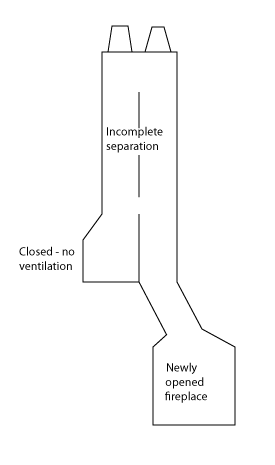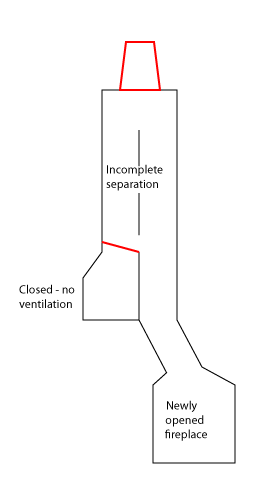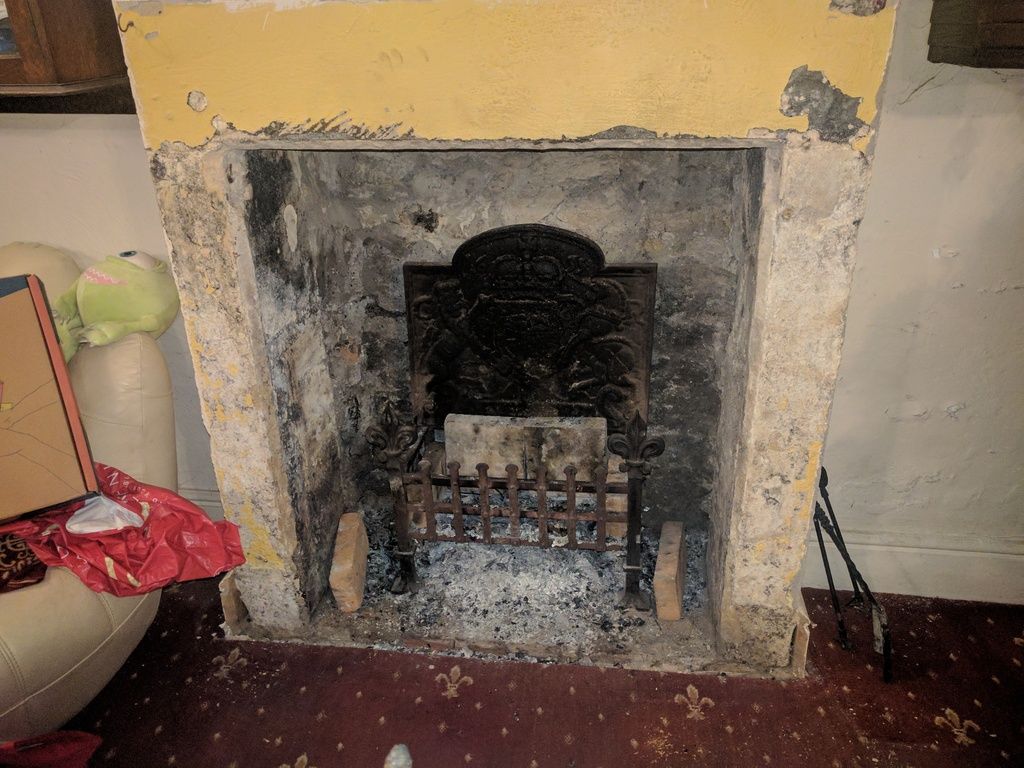So, in time for Christmas, I opened up one of the original fireplaces, ripping out the rusted to bits mini range that had been installed in the 1920s and which was beyond repair. 20 rubble sacks later I had a large open heath, into which I whacked in a large dog grate.
Now, the draw on it is ok, not great, but it did for Christmas, if it got too smoky, a periodic opening of the back door helped to increase the draw to get it all going the right way again. Now I have been looking at remedying the situation further, I shoved the grate as far back into the fireplace as possible, and put fire bricks around the back and sides, the theory being that this will help to force more air to be drawn in from the front. A smoky test fire later, and this have improved but are still not perfect.
This is where the plot thickens. The flue is a shared one, doing the living room fireplace downstairs, and what used to be one in the bedroom upstairs (currently closed off and behind a built in wardrobe. I stepped outside however and noticed smoke coming out of both chimney pots. What I suspect therefore is that when the mason rebuilt my stack and made repairs to the flue (at considerable expense I may add) - he neglected to rebuild the central "divider". Initial torch assisted peering seems to confirm this. Thus I suspect I now have the following:

The smoke goes up the first section, and then hits the now effectively double width flue, loses most of its velocity, cools and sinks into the dead zone in the unventilated closed up fireplace, the rest just about ambles on up and out the two flues.
The ideal solution would be to take the entire lot apart again and rebuild the central divide, but that ain't gonna happen. So... My initial plan is just to replace the double squat pots on top, with a larger diameter, taller, single centrally mounted pot. The extra height should take it further above the neighbours roofline, which should help things. Going to a single central wider pot should increase the final exhaust velocity, which should also help improve draw. It will also reduce the likelihood of smoke going out one pot and back in the other when the wind starts messing around.
Now, the draw on it is ok, not great, but it did for Christmas, if it got too smoky, a periodic opening of the back door helped to increase the draw to get it all going the right way again. Now I have been looking at remedying the situation further, I shoved the grate as far back into the fireplace as possible, and put fire bricks around the back and sides, the theory being that this will help to force more air to be drawn in from the front. A smoky test fire later, and this have improved but are still not perfect.
This is where the plot thickens. The flue is a shared one, doing the living room fireplace downstairs, and what used to be one in the bedroom upstairs (currently closed off and behind a built in wardrobe. I stepped outside however and noticed smoke coming out of both chimney pots. What I suspect therefore is that when the mason rebuilt my stack and made repairs to the flue (at considerable expense I may add) - he neglected to rebuild the central "divider". Initial torch assisted peering seems to confirm this. Thus I suspect I now have the following:

The smoke goes up the first section, and then hits the now effectively double width flue, loses most of its velocity, cools and sinks into the dead zone in the unventilated closed up fireplace, the rest just about ambles on up and out the two flues.
The ideal solution would be to take the entire lot apart again and rebuild the central divide, but that ain't gonna happen. So... My initial plan is just to replace the double squat pots on top, with a larger diameter, taller, single centrally mounted pot. The extra height should take it further above the neighbours roofline, which should help things. Going to a single central wider pot should increase the final exhaust velocity, which should also help improve draw. It will also reduce the likelihood of smoke going out one pot and back in the other when the wind starts messing around.




